Start Licensing’s Ian Downes takes a trip to Bluewater in Kent and discovers how licensing is playing a part in adding value to the shopping experience.
I found myself in Bluewater this week. Intentionally I might add. Bluewater is an out of town shopping centre located in Greenhithe in Kent. It is well served transport wise and has a broad catchment area. I travelled there by train and bus, but it is a popular destination with car drivers.
It was opened in 1999 and is one of the largest shopping centres in the UK. It is definitely on the retail map for local shoppers. I am sure it is an important part of the local economy and is a big local employer. I sense Bluewater takes a pride in being part of a community and embrace the fact that it has a role to play in the community.
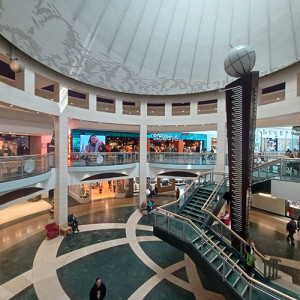 I visited Bluewater on a Tuesday afternoon and was pleased to see how busy it was on an afternoon when I thought would be relatively quiet – there were lots of shoppers at the centre and, pleasingly, they were making purchases. The centre has a really good mix of retailers including the likes of John Lewis and M&S. It is also a centre that is blending food and beverage, entertainment and ‘pop up’ retailing into its offer. I think like other similar centres, Bluewater has had to adapt to a changing retail market and also develop new opportunities that tap into the wider leisure market.
I visited Bluewater on a Tuesday afternoon and was pleased to see how busy it was on an afternoon when I thought would be relatively quiet – there were lots of shoppers at the centre and, pleasingly, they were making purchases. The centre has a really good mix of retailers including the likes of John Lewis and M&S. It is also a centre that is blending food and beverage, entertainment and ‘pop up’ retailing into its offer. I think like other similar centres, Bluewater has had to adapt to a changing retail market and also develop new opportunities that tap into the wider leisure market.
For a centre that was first opened in 1999 it retains a very modern feel, it is well presented and had a vibrancy about it. It was good to see that Bluewater sets high standards in presentation terms and that it is delivering a positive shopping experience. Given the size and scale of Bluewater I wasn’t able to visit all stores, but did manage to pop in to a fair few retailers. Licensing was certainly a feature in the shops I visited and my sense was that in the context of a shopping location like Bluewater, licensing and licensed products were very relevant. It is, of course, a destination retailer – shoppers make a conscious decision to shop there and for many it is about having a rewarding shopping experience. In this context popular licensed brands have a role to play. A measure of this was how many licensed brands and products I saw ‘starring’ in shop windows.
My first port of call was Bluewater’s M&S. It is a large format store. My visit was well timed Christmas wise as the store had a dedicated Christmas Market area up and running. This was well signposted including a Christmas arch that shoppers walked through to enter the Market. A nice seasonal touch. M&S had put a lot of effort to deliver retail theatre.
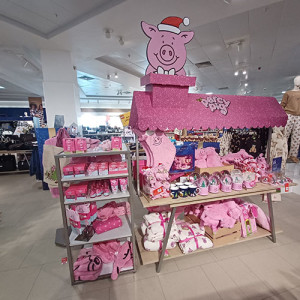 One thing that struck me immediately was how M&S is leveraging its own IP – its character Percy Pig was front and centre in the Christmas Market with a broad range of gift-related products. Having access to its own character brand probably works for M&S in regards to NPD, long-term planning and margin protection. M&S supporting Percy Pig and Colin the Caterpillar arguably means that there are less opportunities for other character brands as they would need to replace Percy and Colin on shelf. A tough challenge.
One thing that struck me immediately was how M&S is leveraging its own IP – its character Percy Pig was front and centre in the Christmas Market with a broad range of gift-related products. Having access to its own character brand probably works for M&S in regards to NPD, long-term planning and margin protection. M&S supporting Percy Pig and Colin the Caterpillar arguably means that there are less opportunities for other character brands as they would need to replace Percy and Colin on shelf. A tough challenge.
M&S has created islands of products in its Christmas Market including a range of LEGO products which included licensed lines such as Disney and Star Wars. Other featured licensed brands in the Christmas Market included Frozen (celebrating its 10th anniversary), Marvel and Harry Potter – all three featured on a shared FSDU with products such as plush, toiletries and apparel on offer. Another feature at M&S was partnerships with brands such as Fired Earth where it had curated a homewares range together. It was also interesting to see M&S using heritage brands such as William Morris across a range of product categories such as bedding – it had a William Morris bedroom set to help sell the range. Other brands in the bedding department included Marvel, Harry Potter and Snoopy. Outside of the Christmas ranges, M&S was still supporting some stalwart brands such as Peter Rabbit. I think Peter Rabbit has been part of the M&S product offering for some time now. Paddington and The Gruffalo apparel lines were also present in-store. M&S also provided a window on how the nature of retailing is changing in regards to supporting other retail brands within its store – this branch had a dedicated Early Learning Centre concession for example. I think this is a style of retailing that might become more common.
Another interesting example of licensing that I saw at Bluewater was gallery retailer Castle Fine Art which had a Stan Lee x Marvel print collection featured prominently in its window – a reminder of how pop culture is having an impact in markets such as art prints and home interiors. It is also a reminder that increasingly rights owners have to develop and implement a multi tier retail strategy. As an example wall art can take on lots of formats, price points and design styles. Castle Fine Art is positioned relatively high-end and work with a range of artists to create ‘exclusive art’ collections.
Sticking with pop culture, Bluewater had branches of both HMV and MenKind. These are two retailers which have created new opportunities for licensing with its support of fan driven merchandise. It supports genres such as animation, comics, music, manga and anime.
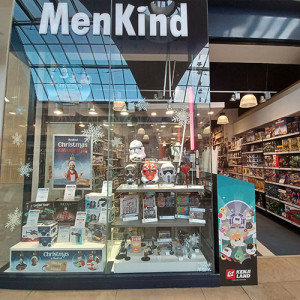 MenKind’s window display included a range of Star Wars helmets – products developed for the fan and collector markets. But also displayed to capitalise on the Christmas gift market and appeal to consumers looking for a ‘special’ present for the Star wars fan in their life.
MenKind’s window display included a range of Star Wars helmets – products developed for the fan and collector markets. But also displayed to capitalise on the Christmas gift market and appeal to consumers looking for a ‘special’ present for the Star wars fan in their life.
Beyond buying into franchises like Star Wars, MenKind has always seemed to support food gifting at this time of year. It is a category that seems to work well for it. This year’s offering included composite gifts featuring brands such as Bailey’s, Pot Noodle and Marmite. For these brand owners, being in a retailer like MenKind fulfils a core part of the licensing strategy. They are reaching consumers in new retail channels and settings.
It was also interesting to see products such as a Hairy Bikers sausage roll maker, Pokémon cheese toastie maker and a Minecraft waffle maker. Three good examples of how licensing can make an impact in a sector like this and stimulate some new NPD in the category. It also illustrates how gifts and gifting can create an opportunity for new types of products. To reinforce my earlier point about how IP owners need to have a multi-tier retail strategy in certain categories, it was interesting to see an Abysse sales unit in-store filled with framed prints. This also underpinned the role that licensees can play in curating a category for retailers – I suspect MenKind respects the way Abysse manages this programme and the licence selections it makes.
The Bluewater HMV shop was another great example of how HMV is curating pop culture and fan driven merchandise. It offered a good mix of products, with current product selection leaning into the Christmas market with features such as a calendar spinner. Unsurprisingly, music was a big part of the product mix here with calendars featuring the likes of David Bowie, Pink Floyd and AC/DC among the selections on offer. HMV also has a keen eye on providing value and a positive shopping experience to its customers. Front of store there was a very prominent display of gift packs which were keenly priced. I suspect this appeals to consumers on a number of levels – value for money being one, but also I suspect they enjoyed shopping the fixture to review the latest offers. In this context I think consumers are growing to trust HMV’s product selections and feel that they will almost certainly find the ‘latest’ products they are seeking out.
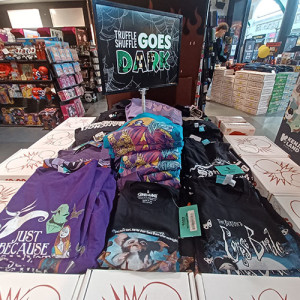 It was also interesting to see well established ecommerce retailer TruffleShuffle featured in HMV. TruffleShuffle has developed a great business focused on licensing pop culture and fan brands into categories like apparel. TruffleShuffle has a good track record of developing exclusive designs setting it apart from other apparel ranges. It has a good understanding of what appeals to consumers about brands using this insight to inform design. It seems HMV has teamed up with it to feature a TruffleShuffle-curated selection in-store recognising the equity in the TruffleShuffle name. Truffleshuffle is a brand that HMV’s customers will know and trust. The current selection was centred around Halloween and was presented under a TruffleShuffle Goes Dark theme.
It was also interesting to see well established ecommerce retailer TruffleShuffle featured in HMV. TruffleShuffle has developed a great business focused on licensing pop culture and fan brands into categories like apparel. TruffleShuffle has a good track record of developing exclusive designs setting it apart from other apparel ranges. It has a good understanding of what appeals to consumers about brands using this insight to inform design. It seems HMV has teamed up with it to feature a TruffleShuffle-curated selection in-store recognising the equity in the TruffleShuffle name. Truffleshuffle is a brand that HMV’s customers will know and trust. The current selection was centred around Halloween and was presented under a TruffleShuffle Goes Dark theme.
My visit to HMV also reminded me how certain products have flourished because of fan demand and engagement – the example I saw that reminded me of this was a display of doormats from Pyramid featuring a range of pop culture brands. This is a category that probably wouldn’t exist without the rise of fan driven merchandise.
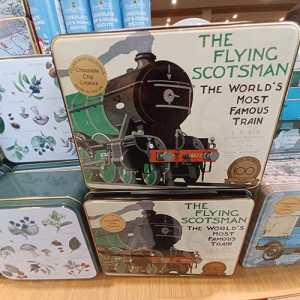 Lakeland is a retailer that has used licensing across the years often with exclusive ranges, but these days it seems to be content to cherry pick products from suppliers that it is trading with. Again, it is turning its attention to the Christmas gifting opportunity and focusing on seasonal products. A front of store display included a gift tin of biscuits from Elite Gifts featuring The Flying Scotsman.
Lakeland is a retailer that has used licensing across the years often with exclusive ranges, but these days it seems to be content to cherry pick products from suppliers that it is trading with. Again, it is turning its attention to the Christmas gifting opportunity and focusing on seasonal products. A front of store display included a gift tin of biscuits from Elite Gifts featuring The Flying Scotsman.
It was also interesting to see an end cap display of products featuring The Snowman and Peter Rabbit that mixed practical baking items like cake toppers with gift items like tea towels. Of course, The Snowman comes into its own at this time of year. A skillset here is to balance NPD with perennial sellers while retaining shelf space. This can be a challenge for classic brands. It was also interesting to see food gifting products from Crème D’Or featuring the Natural History Museum – there were two ranges on sale – one billed as the Botanical Collection and the other Love Your World which appealed to younger consumers. Another good example of how heritage brands are becoming regular fixtures at retail. It is also a good reminder that brand owners can benefit from investing in design not least by creating distinct design styles that work for different consumer groups.
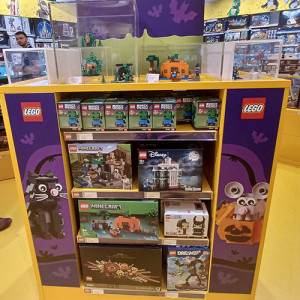 Unsurprisingly, Bluewater had a number of brand lead ‘theme’ stores including a nicely set out LEGO store. The company seems to manage its retail estate well and delivers a store experience which is consistently good. It also seems to chose its staff well and has shop staff who are engaged with customers plus product experts. Underlining the value and potential in making ‘real world’ shopping a value added experience.
Unsurprisingly, Bluewater had a number of brand lead ‘theme’ stores including a nicely set out LEGO store. The company seems to manage its retail estate well and delivers a store experience which is consistently good. It also seems to chose its staff well and has shop staff who are engaged with customers plus product experts. Underlining the value and potential in making ‘real world’ shopping a value added experience.
It was interesting to see that LEGO was tapping into the Halloween market with a display that included brands like Disney’s The Haunted Mansion and also Minecraft. There was a wall of Star Wars product supported by window displays and in shop models. The LEGO store was definitely an experiential lead one where displays piqued consumers’ interest. It was also interesting to see a Steamboat Willy model kit and to note that it was being used as part of a price promotion encouraging people to up their spend to get a ‘free’ kit. LEGO was a great example of a retailer using its window displays to sell its products and to pull in customers.
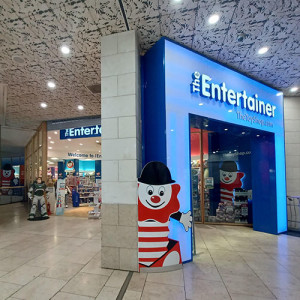 The Entertainer is also a Bluewater tenant. It had copies of its Santa’s Toy Shop catalogue available which was showcasing some of the key lines and promotions. Licensing and licensed brands featured throughout the brochure. Cover star brands include Barbie, Star Wars and Teenage Mutant Turtles. The catalogue was well curated and divided into sections such as Preschool and Games. The Early Learning Centre brand was also part of the product mix. Preschool wise featured brands included PAW Patrol, Peppa Pig, Gabby’s Dollhouse and CoComelon. The PAW Patrol range included a Mighty Movie range. The Entertainer manages to mix licensing and classic toy brands well achieving a good balance while managing risk well. Arts and crafts is a strong theme and one that licensing plays a role in.
The Entertainer is also a Bluewater tenant. It had copies of its Santa’s Toy Shop catalogue available which was showcasing some of the key lines and promotions. Licensing and licensed brands featured throughout the brochure. Cover star brands include Barbie, Star Wars and Teenage Mutant Turtles. The catalogue was well curated and divided into sections such as Preschool and Games. The Early Learning Centre brand was also part of the product mix. Preschool wise featured brands included PAW Patrol, Peppa Pig, Gabby’s Dollhouse and CoComelon. The PAW Patrol range included a Mighty Movie range. The Entertainer manages to mix licensing and classic toy brands well achieving a good balance while managing risk well. Arts and crafts is a strong theme and one that licensing plays a role in.
The Entertainer has also responded well to the current financial challenges consumers are facing with a heavy emphasis on value offers and pricing presented under a Santa’s Savers banner. Licensed products featured in this scheme with the likes of Star Wars, Marvel and Trolls being featured. Plush was also a big part of The Entertainer product mix, with Squishmallows being a product line that stood out in particular. The Entertainer is a really good example of a retailer that has managed to harness the potential of licensing well, underpinning this with good product knowledge and having a good sense of what trends to support as well.
It was also good to see retailers such as Typo in Bluewater and interesting to note its commitment to licensing. Typo had a very significant range of Grinch products including jumpers, shirts, gift bags and greetings cards. It seemed to have been able to develop a range with its own design style and handwriting.
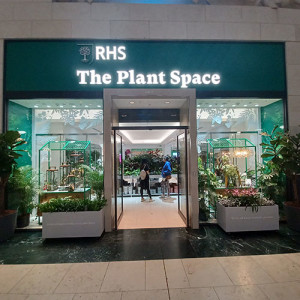 You will be pleased to know that I did actually spend some money during my Bluewater tour – I noticed that the RHS had a shop called The Plant Space. I subsequently found out that was the RHS’ first standalone shop. The motivation behind it was to help the RHS connect with a new generation of consumers, specifically younger consumers who may not have gardens but are interested in houseplants, balcony gardens and indoor gardening. A driver for the RHS behind this concept store was data that showed that sales of RHS houseplants had risen by 32% in the last three years. The Plant Store mixed houseplants with gift items, books and gardening equipment. It was a really well presented shop that felt very contemporary and stylish. It is a very proactive move by the RHS and great to see a shop like this in Bluewater.
You will be pleased to know that I did actually spend some money during my Bluewater tour – I noticed that the RHS had a shop called The Plant Space. I subsequently found out that was the RHS’ first standalone shop. The motivation behind it was to help the RHS connect with a new generation of consumers, specifically younger consumers who may not have gardens but are interested in houseplants, balcony gardens and indoor gardening. A driver for the RHS behind this concept store was data that showed that sales of RHS houseplants had risen by 32% in the last three years. The Plant Store mixed houseplants with gift items, books and gardening equipment. It was a really well presented shop that felt very contemporary and stylish. It is a very proactive move by the RHS and great to see a shop like this in Bluewater.
One of the strengths of a location like Bluewater is its ability to support new retail concepts, particularly those that have an experiential element to them. The Plant Space hosts in-store events including talks and demos. It is a great platform for the RHS and a proactive way of reaching new consumers. As mentioned, I made some purchases in The Plant Space but these have to remain under wraps until 26 December…
My visit to Bluewater was an enjoyable one and a reminder that shopping can be a good experience – Bluewater seems to have found a successful formula that is making the most of the retail estate in challenging times. The retail tenants are playing their part by making sure their shops are well stocked, imaginatively presented and their staff are great ambassadors for their brands. It was also good to see licensing playing its part in adding value to the shopping experience.
Ian Downes runs Start Licensing, an independent brand licensing agency. His Twitter handle is @startlicensing – he would welcome your suggestions for what to look out for.






























